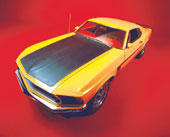 |
 |
| A 1969 Ford Mustang Boss; (above) a 1970 Dodge |
Any car enthusiast worth his or her salt must have, at one time or another, wished that the car he or she drives had more power, more muscle. In fact, it’s quite a common thing for car enthusiasts to take the engine out of the car that they own and drop a more powerful engine into it. It’s been done a lot in the past ? Triumph and Fiat (Padmini) engines in Morris Minors, Fiat engines in Standard Heralds, Isuzu engines in Maruti Gypsies.
Of late, drag strips in India have been seeing lightened Maruti Zens with Esteem engines tearing down them. So why don’t manufacturers come out with cars that have more powerful engines? The answer is that in the interests of fuel economy and reliability, all manufacturers play safe. At well over Rs 40 and close to Rs 50 to a litre, the essential need of the common car user is a fuel- efficient car. So the majority of cars have engine sizes limited to 1.6-litres (1600cc).
There was however, a time when fuel was cheap ? very cheap. In the ‘50s, ‘60s and ‘70s, American car manufacturers were making lots of cars with fuel-guzzling V8 engines. Each range would have one or two high performance versions and these came to be known as muscle cars. In fact, the unofficial definition of a muscle car is a medium-sized car with high performance, available at a price that was not much higher than the other vehicles in the range.
Muscle cars ? also known as factory hot rods ? were very much an American phenomenon. The phenomenon was largely driven by the development of engines. Chrysler is generally given the credit for starting off the muscle car period thanks to developing the Firepower V8 engine.
This became popularly known as the Chrysler Hemi, because of the combustion chamber design that was hemispherical. It developed 180bhp, which is not much in today’s terms, but was huge in those days. This engine took Chrysler’s image from being a manufacturer of solid, ordinary but reliable cars to a manufacturer of exciting cars that allowed Americans to indulge in high performance vehicles, just like their friends on the other side of the ‘pond’.
The Hemi was seen in a few Dodge models too, like the Charger. Next to step in was GM and in 1955, the people’s V8 engine from Chevrolet, a company reputed as a manufacturer of cheap cars, established that engine configuration as the standard engine.
Muscle cars can be split according to size. There was the full-size muscle car like the SS or Super Sport version of the Chevrolet Impala and the pony cars, which were smaller but had very powerful engines in them, like a Camaro or a Mustang. The pony cars were also available with a 6.7-litre engine, simply known as the 409, developing 409bhp thanks to two four-choke carburettors. This car could do the quarter-mile (400 metre) run on the drag strip in less than 13 seconds. The best part was that one could order the SS package for an Impala for just over $50!
While it was the engine that was the highpoint in this car, later Chevrolets, especially the pony cars, combined style with substance ? the Chevrolet Camaro Z/28 of 1967 was much more than just eye-candy. Built to Trans Am specs, these could do 0-60mph in less than six seconds and had a top speed of around 200kph. Camaros also came in an SS version to compete with the Ford Mustang GT.
Ford’s muscle cars were also right up there with the rest of the pack. The Galaxie 500XL was a full-sized muscle car that looked like a big 60s cruiser. Though it weighed close to 4,000lb, it could do the quarter mile in 15 seconds and get to 60mph in about seven seconds thanks to the huge 405bhp Thunderbird Special engine, which drank fuel by the barrel.
However, April of 1964 saw an epoch-making launch from Ford. The Mustang, which was targeted at the youth, was based around a 4.7- litre (289 cubic inch) engine developing 271bhp. It could do close to 200kph. The brainchild of Lee Iacocca who was the general manager of Ford at the time, the first 100 days saw 100,000 cars being sold, which was the sales figure the company had projected for the whole year. In fact, by the year end, 418,812 Mustangs had been sold. Mustangs were available in three styles ? a notchback, a convertible and a sporty fastback. The Boss 429 limited version meant for racing had a seven-litre engine in it. With 375bhp of power and 410lb-ft of torque on tap, it did quarter-miles in 14 seconds and 0 to 60mph in 7.1 seconds. Ford sold 857 of these.
Manufacturers were quick to see that the muscle car phenomenon was not to be underestimated and almost all hopped onto the bandwagon ? Dodge, Plymouth, Pontiac, Ford and even Buick and Oldsmobile. For two decades, Americans revelled in muscle car performance that was also driven by the need to excel in NASCAR racing. But the fuel crisis in the 70s and the increasingly tough emission regulations put an end to the good old muscle cars. Yes, America was responsible for a lot of fossil fuel reserve depletion over those 20 years but they were 20 very memorable years for performance car lovers.
Easy listening
 |
Sheena Chohan,
model
I enjoy listening to music that is soothing but at the same time, stirring. In other words, it should have a good rhythm and feel to it.
Nothing then fits the bill better than world music. I really enjoy this genre as it’s a beautiful blend of traditional melodies and contemporary rhythms and mixes. Afro-American beats or baul music can be mixed with modern beats for a sound that never fails to life one up and give a good feeling. Yanni and Bikram Ghosh are just some of my favourite artistes in this category.
Besides world music I really love listening to Rabindrasangeet. In fact, there’s one particular song — Jodi tor dak shuney keu naa aashe, tobe ekla cholo re — which I find very empowering. I’m always humming it or singing it to myself. So, I guess you could say it is my favourite song.











